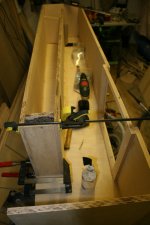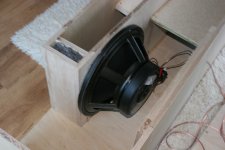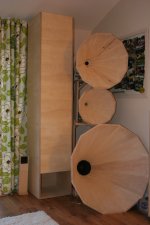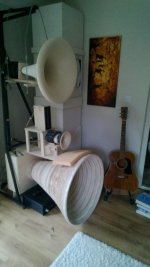I just purchased a TC Sounds LMS Ultra 5400 and I am just wondering if it is better to buy a couple of PRs or port it...
On the TC Sounds website under enclosures it seems you can achieve the same results either way...
LMS-Ultra 5400 18″ Driver | TC Sounds
Very Large Ported
Size Volume Port Length Port Area Tuning
18″ 8.0ft3 90in 6×4in 15Hz
Very Large Dual VMP
Size Volume Number of VMP’s Moving Mass Tuning
12″ 8.4ft3 2×18in 1650g 15Hz
On the TC Sounds website under enclosures it seems you can achieve the same results either way...
LMS-Ultra 5400 18″ Driver | TC Sounds
Very Large Ported
Size Volume Port Length Port Area Tuning
18″ 8.0ft3 90in 6×4in 15Hz
Very Large Dual VMP
Size Volume Number of VMP’s Moving Mass Tuning
12″ 8.4ft3 2×18in 1650g 15Hz
Last edited:
Looking at their spec sheet for recommended enclosures, their port dimensions vs. tuning are WAY, WAY off. A 3.1 cube box with a 4"x4" port only needs a 10.15" long port for a 30hz tuning. Not the 36.5" they list.
Build any of those designs and you'll end up with something MUCH lower than the supposed tuning and a port that's too small. The one you listed is actually tuned to ~9hz.
Without having it winisd, I would guess around 10 cubes with a 15 hz tune and 60-75 in^2 slot port would work pretty good and end up with a reasonable size. I would personally build from medium-high quality plywood.
Build any of those designs and you'll end up with something MUCH lower than the supposed tuning and a port that's too small. The one you listed is actually tuned to ~9hz.
Without having it winisd, I would guess around 10 cubes with a 15 hz tune and 60-75 in^2 slot port would work pretty good and end up with a reasonable size. I would personally build from medium-high quality plywood.
Thanks turbodawg I will throw the specs into Bass Box Pro on the weekend and see what I come up with. Reading through an old thread comparing the 5100 against the 5400, it seems the 5400 may work ok in a sealed enclosure as well.
TC Sounds vs. Data-Bass T/S parameters - LMS Ultra 5400
Look below
Driver : TC Sounds LMS Ultra 5400 18" DVC Subwoofer (2+2 ohm)
Référence : LMS-Ultra 5400
TC Sounds vs. Data-Bass
Fs ( Hz ) : 20.5
VAS ( L ) : 240.7 / 201.1
Re ( Ohms ) : 3.78
Qms : 7.6 / 14.97
Qes : 0.34 / 0.311
Mms ( g ) : 501.3 / 550.3
Sd ( cm2 ) : --- / 1150 (1194.60*)
Inductance Le ( mH ) : 1.96 / 3.57
Xmax ( mm ) +/- : 33.655
* my reference: in the parts express website look here it says that Sd for passive 18" is about Sd: 194.56 sq. cm. I used this parameter as a reference for the LMS-Ultra 5400.
On another note: from the tcsounds website "" Measured with Praxis (voice coil wired in parallel) "" - don't take this to the letter because it says the same for the passive drivers (VMP Passive Radiator). It's obvious that it shows Re measured in series (nominal 4 Ohm). The same measurements are shown in the Parts Express website.
For the data-bass website it doesn't mention the procedure but notice Re is in series also. This might be (small or not) of consequence in the final design of the speakers (enclosures and it's alignments) based on the data sheets used by each. 😀
LMS-Ultra 5400 18″ Driver | TC Sounds
Data-Bass
TC Sounds VMP 18" Passive Radiator 293-684
A lot of questions ?!
Look below
Driver : TC Sounds LMS Ultra 5400 18" DVC Subwoofer (2+2 ohm)
Référence : LMS-Ultra 5400
TC Sounds vs. Data-Bass
Fs ( Hz ) : 20.5
VAS ( L ) : 240.7 / 201.1
Re ( Ohms ) : 3.78
Qms : 7.6 / 14.97
Qes : 0.34 / 0.311
Mms ( g ) : 501.3 / 550.3
Sd ( cm2 ) : --- / 1150 (1194.60*)
Inductance Le ( mH ) : 1.96 / 3.57
Xmax ( mm ) +/- : 33.655
* my reference: in the parts express website look here it says that Sd for passive 18" is about Sd: 194.56 sq. cm. I used this parameter as a reference for the LMS-Ultra 5400.
On another note: from the tcsounds website "" Measured with Praxis (voice coil wired in parallel) "" - don't take this to the letter because it says the same for the passive drivers (VMP Passive Radiator). It's obvious that it shows Re measured in series (nominal 4 Ohm). The same measurements are shown in the Parts Express website.
For the data-bass website it doesn't mention the procedure but notice Re is in series also. This might be (small or not) of consequence in the final design of the speakers (enclosures and it's alignments) based on the data sheets used by each. 😀
LMS-Ultra 5400 18″ Driver | TC Sounds
Data-Bass
TC Sounds VMP 18" Passive Radiator 293-684
Also you might want to check out these PR's when your modeling.
18" Passive Radiator | PSI Car Audio
I have used a bunch of PR's on different projects including one of these with a 15" tc sounds 3000 and it turned out amazing. I think its the best PR you can get for the money.
18" Passive Radiator | PSI Car Audio
I have used a bunch of PR's on different projects including one of these with a 15" tc sounds 3000 and it turned out amazing. I think its the best PR you can get for the money.
I spent a bit of time yesterday modeling up sealed, ported and PR enclosures in Bass Box Pro.
the driver selection tool suggests that this driver is far more suited to a closed enclosure than it is a port one.
but upon making a few bigger BR designs I noticed I was getting far better looking graphs using ported boxes, which makes me think while a driver might be better suited to one cabinet type or another by virtue of the TS parameters, should you really use that box type?
the driver selection tool suggests that this driver is far more suited to a closed enclosure than it is a port one.
but upon making a few bigger BR designs I noticed I was getting far better looking graphs using ported boxes, which makes me think while a driver might be better suited to one cabinet type or another by virtue of the TS parameters, should you really use that box type?
You should use whichever cabinet type gives you the response curve and output that you are looking for.
A passive radiator design will have ideally exactly the same response and output as a good BR design. You are trading the cost of the PR for a slightly smaller box (the size of the box that was taken up by the port area is removed), and no port compression or noise.
When designing a PR box, I usually design my ideal BR box first and then just model my PR box after that. As an example in your case. I modeled the BR box I would want if I was using that driver in my home theater, then I model a PR design using the PSI radiator I mentioned above to recreate that box. Winisd calculates with the net square footage of the box, so even though the calculated volume is the same in both, the PR box will be minus the size of the port, which in this case is quite big.
A port that is 24"x3"x84 will get you to roughly 17 m/s air speed at your cutoff frequency for a 5 ft3 box. Some studies recommend staying under 10 m/s if you don't ever want to hear it, though usually anything under 30 is ok with me. Anyways that means your port would add an additional 3.5 cubic feet to your box in port area. If you were ok with 30 m/s vent speed than a vent with the same tuning would be 24"x1.5"x41", which would add another .85 cubic ft to your box size. In either case you can see how going with a PR saves you a considerable amount of box size if you are properly designing for port velocity.
I have attached the boxes that I would personally make with that driver for home theater.
The box with the Yellow line is an 8ft3 box as TC sounds recommends with 2 18" PR's. I would only build this if space was literally no factor and you never had to move these again. Pretty much all normal rooms will reinforce the lower frequencies and any eqing will most likely eliminate the advantages of this box.
The box design in grey is a normal 5ft3 ported enclosure with the vent length's that I described above. Remember the vents are in addition to the stated enclosure size.
The box design in magenta is a 5ft3 dual PR design tuned to the FS of the driver which is 20.5hz. You will add about 900 grams of weight to both of the 18' PSI PR's to achieve this tuning. The volume taken up by the PR's is also in addition to the calculated volume so in this case you would want to build a box with 5.26 ft3 internal volume.
Also remember that all of these designs will exceed max excursion at 2000 watts (modeled in graph) very quickly below 20 hz. So you need to have a high pass filter at 15hz or so.
A passive radiator design will have ideally exactly the same response and output as a good BR design. You are trading the cost of the PR for a slightly smaller box (the size of the box that was taken up by the port area is removed), and no port compression or noise.
When designing a PR box, I usually design my ideal BR box first and then just model my PR box after that. As an example in your case. I modeled the BR box I would want if I was using that driver in my home theater, then I model a PR design using the PSI radiator I mentioned above to recreate that box. Winisd calculates with the net square footage of the box, so even though the calculated volume is the same in both, the PR box will be minus the size of the port, which in this case is quite big.
A port that is 24"x3"x84 will get you to roughly 17 m/s air speed at your cutoff frequency for a 5 ft3 box. Some studies recommend staying under 10 m/s if you don't ever want to hear it, though usually anything under 30 is ok with me. Anyways that means your port would add an additional 3.5 cubic feet to your box in port area. If you were ok with 30 m/s vent speed than a vent with the same tuning would be 24"x1.5"x41", which would add another .85 cubic ft to your box size. In either case you can see how going with a PR saves you a considerable amount of box size if you are properly designing for port velocity.
I have attached the boxes that I would personally make with that driver for home theater.
An externally hosted image should be here but it was not working when we last tested it.
The box with the Yellow line is an 8ft3 box as TC sounds recommends with 2 18" PR's. I would only build this if space was literally no factor and you never had to move these again. Pretty much all normal rooms will reinforce the lower frequencies and any eqing will most likely eliminate the advantages of this box.
The box design in grey is a normal 5ft3 ported enclosure with the vent length's that I described above. Remember the vents are in addition to the stated enclosure size.
The box design in magenta is a 5ft3 dual PR design tuned to the FS of the driver which is 20.5hz. You will add about 900 grams of weight to both of the 18' PSI PR's to achieve this tuning. The volume taken up by the PR's is also in addition to the calculated volume so in this case you would want to build a box with 5.26 ft3 internal volume.
Also remember that all of these designs will exceed max excursion at 2000 watts (modeled in graph) very quickly below 20 hz. So you need to have a high pass filter at 15hz or so.
Last edited:
Here is the sealed recommended box vs the box I would recommend as described above.
The PR box in this case is modeled with a 4th order HPF at 15hz to prevent over excursion. You can see that you would not see any benefit to a sealed box until 16.3hz, and you would be giving up considerable output. Also the response of all of these boxes will be changed drastically by whatever room you put it in. You will gain at least 6db on the low end and sometimes 12db in most rooms depending on size of the room and location of the sub.
Any quest for flat frequency response will need room equalization, and any quest for flat frequency response in more than one location will need room equalization and more than one sub.
An externally hosted image should be here but it was not working when we last tested it.
The PR box in this case is modeled with a 4th order HPF at 15hz to prevent over excursion. You can see that you would not see any benefit to a sealed box until 16.3hz, and you would be giving up considerable output. Also the response of all of these boxes will be changed drastically by whatever room you put it in. You will gain at least 6db on the low end and sometimes 12db in most rooms depending on size of the room and location of the sub.
Any quest for flat frequency response will need room equalization, and any quest for flat frequency response in more than one location will need room equalization and more than one sub.
Last edited:
I was possibly thinking about a 3 SW system as suggested in another thread. The 5400 used in something like this "http://www.data-bass.com/data?page=system&id=8" to do the real grunt work, and the two 5100s used up a little higher. Allowing each driver to work in best comfort zone and creating a blended sub.
Earlier Geddes approach was discussed here http://www.diyaudio.com/forums/subwoofers/232079-underground-sub-3.html using different placement and subs to create a blanket of sound.
Earlier Geddes approach was discussed here http://www.diyaudio.com/forums/subwoofers/232079-underground-sub-3.html using different placement and subs to create a blanket of sound.
Last edited:
Have you checked out the Gjallerhorn?
http://www.diyaudio.com/forums/subwoofers/189784-gjallerhorn.html
Someday I am going to have one of these on each side of my theater!
http://www.diyaudio.com/forums/subwoofers/189784-gjallerhorn.html
Someday I am going to have one of these on each side of my theater!
Last edited:
I hadn't but I am going to put the numbers in Hornresp and see what it looks like. I don't think I would maybe use as many turns or mount the driver hanging but is just all down to folding the box.
You should use whichever cabinet type gives you the response curve and output that you are looking for.
A passive radiator design will have ideally exactly the same response and output as a good BR design. You are trading the cost of the PR for a slightly smaller box (the size of the box that was taken up by the port area is removed), and no port compression or noise.
When designing a PR box, I usually design my ideal BR box first and then just model my PR box after that. As an example in your case. I modeled the BR box I would want if I was using that driver in my home theater, then I model a PR design using the PSI radiator I mentioned above to recreate that box. Winisd calculates with the net square footage of the box, so even though the calculated volume is the same in both, the PR box will be minus the size of the port, which in this case is quite big.
A port that is 24"x3"x84 will get you to roughly 17 m/s air speed at your cutoff frequency for a 5 ft3 box. Some studies recommend staying under 10 m/s if you don't ever want to hear it, though usually anything under 30 is ok with me. Anyways that means your port would add an additional 3.5 cubic feet to your box in port area. If you were ok with 30 m/s vent speed than a vent with the same tuning would be 24"x1.5"x41", which would add another .85 cubic ft to your box size. In either case you can see how going with a PR saves you a considerable amount of box size if you are properly designing for port velocity.
I have attached the boxes that I would personally make with that driver for home theater.
An externally hosted image should be here but it was not working when we last tested it.
The box with the Yellow line is an 8ft3 box as TC sounds recommends with 2 18" PR's. I would only build this if space was literally no factor and you never had to move these again. Pretty much all normal rooms will reinforce the lower frequencies and any eqing will most likely eliminate the advantages of this box.
The box design in grey is a normal 5ft3 ported enclosure with the vent length's that I described above. Remember the vents are in addition to the stated enclosure size.
The box design in magenta is a 5ft3 dual PR design tuned to the FS of the driver which is 20.5hz. You will add about 900 grams of weight to both of the 18' PSI PR's to achieve this tuning. The volume taken up by the PR's is also in addition to the calculated volume so in this case you would want to build a box with 5.26 ft3 internal volume.
Also remember that all of these designs will exceed max excursion at 2000 watts (modeled in graph) very quickly below 20 hz. So you need to have a high pass filter at 15hz or so.
Great designs, but why not a lower tuning per the original post....?
If I am doing a one driver design I usually try to keep the tuning frequency close to the fs of the driver. Modeling too much below the FS of the driver seems to trade too much efficiency for extension. Not a problem if your willing to throw more drivers at it, but I initially thought he was only planning on using one driver.
Assuming that if you model my box verses one tuned to 15 hz, you end up with a much bigger box because of the extra port area required, and the point at which the box tuned to 15 hz gets more than 3 db louder than the one tuned to 20.5 is roughly 15 hz. However you will have to have a high pass filter to limit excursion on the lower tuned box at around 12 hz. So you gain whatmaybe is noticeable output for 2-3 hz, in return for a bigger box and 3 db loss of output from 21-30hz.
I also am of the opinion that noticeable increase in loudness requires much more than a 3db increase at subsonic frequencies. 3db is the point at which the studies have shown we can discern an increase in frequency ranges that our ears are sensitive too. For infrasonics I believe the increase needed is greater.
I highly doubt if we built these boxes that anyone would be able to hear the difference between them. One would just be bigger.
Now if his purpose is to create infrasonics, and his goals for output have already been/will still be achieved, than I would tune lower.
Assuming that if you model my box verses one tuned to 15 hz, you end up with a much bigger box because of the extra port area required, and the point at which the box tuned to 15 hz gets more than 3 db louder than the one tuned to 20.5 is roughly 15 hz. However you will have to have a high pass filter to limit excursion on the lower tuned box at around 12 hz. So you gain whatmaybe is noticeable output for 2-3 hz, in return for a bigger box and 3 db loss of output from 21-30hz.
I also am of the opinion that noticeable increase in loudness requires much more than a 3db increase at subsonic frequencies. 3db is the point at which the studies have shown we can discern an increase in frequency ranges that our ears are sensitive too. For infrasonics I believe the increase needed is greater.
I highly doubt if we built these boxes that anyone would be able to hear the difference between them. One would just be bigger.
Now if his purpose is to create infrasonics, and his goals for output have already been/will still be achieved, than I would tune lower.
If he is willing to build a Gjallerhorn and has the necessary eq gear, than he will get much more output at all frequencies!
...and a box that he will never want to move. 😛
...and a box that he will never want to move. 😛
Hi Guys just to fill in a few of the missing blanks here... basically the LMS 5400 is going to be a low frequency sub, which will be used for movies only. The two Pro 5100s I am currently using as woofers will also be made into subs, but probably tuned at a higher frequency as per the Geddes 3 sub approach.
I keep looking at the folded horn idea but don't know how to use Hornresp to make sure I am getting the absolute maximum out of it. I can model a more simpler BR box in Bass Box Pro.
The problem is when I put the Gjallerhorn figures in Hornresp the figures don't look as good as a BR box. I don't know if a folded horn would be better, or if the BBP figures are overly optimistic.
So really in two minds which way to box up the LMS 5400. If you look back at the link I posted earlier, you will see that I can brace a BR box far more effectively than a FH.
Edit:
Doesn't matter which box type I choose it is going to be damn heavy!
http://www.data-bass.com/data?page=system&id=8
I keep looking at the folded horn idea but don't know how to use Hornresp to make sure I am getting the absolute maximum out of it. I can model a more simpler BR box in Bass Box Pro.
The problem is when I put the Gjallerhorn figures in Hornresp the figures don't look as good as a BR box. I don't know if a folded horn would be better, or if the BBP figures are overly optimistic.
So really in two minds which way to box up the LMS 5400. If you look back at the link I posted earlier, you will see that I can brace a BR box far more effectively than a FH.
Edit:
Doesn't matter which box type I choose it is going to be damn heavy!
http://www.data-bass.com/data?page=system&id=8
Last edited:
What I have had my eye on for a while now is a thread built around 5 way horns.
http://www.diyaudio.com/forums/mult...-tapped-bass-mids-tweeter-big-boy-system.html
Not really interested in the horn part, but the TH he used for subs in the corners of the room I am.
Ok so it doesn't follow the conventional square box with lots of folds route, but if you don't mind it being tall (which I don't) this would seem a much less complicated box.
Obviously I would look to see if the design could be improved on but the basic up and back would be what I have in mind.

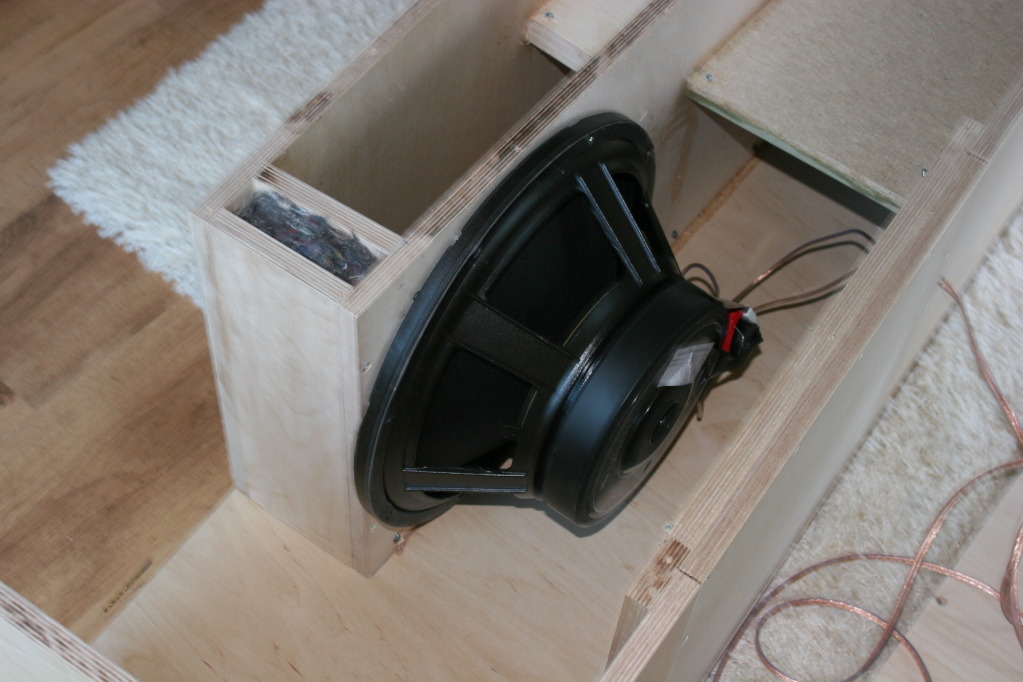
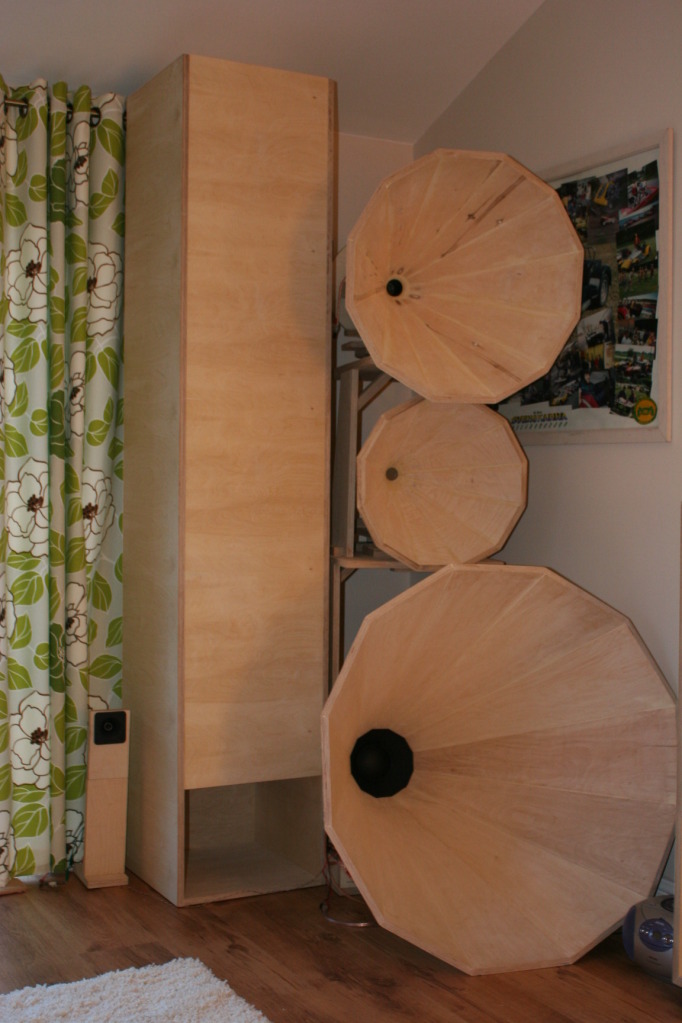
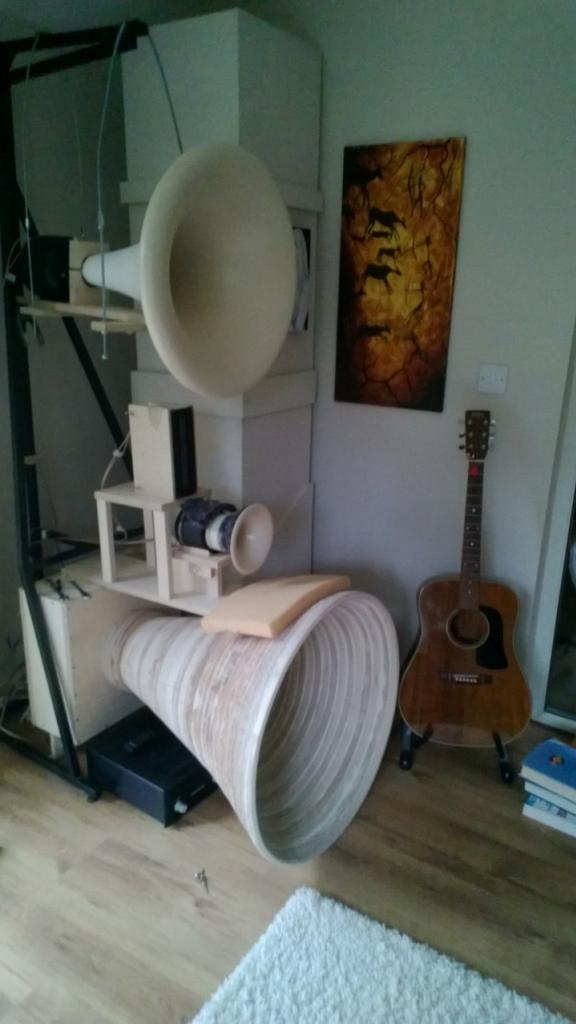
http://www.diyaudio.com/forums/mult...-tapped-bass-mids-tweeter-big-boy-system.html
Not really interested in the horn part, but the TH he used for subs in the corners of the room I am.
Ok so it doesn't follow the conventional square box with lots of folds route, but if you don't mind it being tall (which I don't) this would seem a much less complicated box.
Obviously I would look to see if the design could be improved on but the basic up and back would be what I have in mind.
Attachments
http://www.diyaudio.com/forums/mult...-tapped-bass-mids-tweeter-big-boy-system.html
Not really interested in the horn part, but the TH he used for subs in the corners of the room I am.
Ok so it doesn't follow the conventional square box with lots of folds route, but if you don't mind it being tall (which I don't) this would seem a much less complicated box.
That's actually the prefered format for home use because of the ease of build and the way it tucks into a corner. Folding something to fit into a box is only really needed for PA use. Keep in mind that design doesn't have all that much mouth expansion, and thus won't pick up that much output/sensitivity vs. a ported design. You're also going to want some sort of electronic processor or some other way of time alignment, adding delay to your main speakers/woofers to bring them in-line with the delayed bass from the tapped horns.....
That is a very well designed sub but certainly a bit excessive. I like sylk's design, but would go with a bigger enclosure, with a sightly shorter port and slightly lower tuning.
- Status
- Not open for further replies.
- Home
- Loudspeakers
- Subwoofers
- 2 x PR vs Ported
